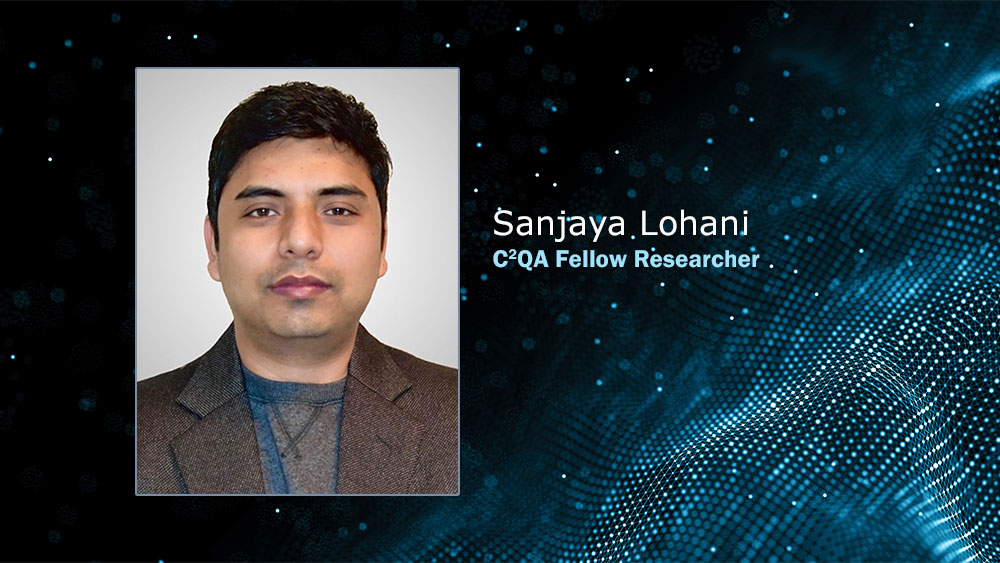Sanjaya Lohani Wins Brookhaven Seed Award Competition for Quantum Information Applications
March 20, 2023
The following news release was originally issued by University of Illinois Chicago (UIC). Sanjaya Lohani is a postdoctoral associate working in associate professor Thomas Searles’s group at UIC, which is helping to advance the mission of the Devices thrust at the Brookhaven Lab-led Co-design Center for Quantum Advantage (C2QA). C2QA is one of five U.S. Department of Energy National Quantum Information Science Research Centers (NQISRCs) established in support of the National Quantum Initiative. For more information on Brookhaven’s involvement, contact Denise Yazak (Dyazak@bnl.gov, 631-344-6371).
Sanjaya Lohani, a postdoctoral associate in Associate Professor Thomas A. Searles group, and a U.S Department of Energy Office of Science Co-design Center for Quantum Advantage (C2QA) fellow researcher, won the first Brookhaven postdoctoral C2QA seed award competition for quantum information applications.
The $50,000 award, for his work ‘Machine learning assisted variational quantum algorithms for near-term quantum information applications,’ is part of C2QA’s Cross-Cutting Research Seed Funding. His co-principal investigators include Chenxu Liu and Yanzhu Chen, both with Virginia Tech, and the award will be split equally between both Virginia Tech and UIC. Lohani is also collaborating with Brian T. Kirby, a quantum science researcher at DEVCOM U.S. Army Laboratory, on the work.
The research centers on finding classical machine learning approaches that can work in conjunction with quantum computing systems. Their goal is to exploit classical machine learning algorithms to push the development of quantum computing hardware.
Classical computing and algorithms are indispensable tools for conducting scientific research.
There are a myriad of problems scientists try to address with machine learning algorithms, but some of the bigger questions cannot easily be tackled with classical computing due to their large datasets. For example, studying various configurations of molecules for use in drug discovery is a very slow process.
“In nature there are many things that cannot be explained by classical algorithms,” Lohani said. “There are certain kinds of things that require quantum mechanics, so in order to grab that information, we will never be able to do that efficiently with classical machine learning.”
Quantum systems behave differently than classical systems. In classical computing, bits of information are conveyed via a series of billions or even trillions of transistors that work in binary, meaning they are in one of two possible states: when a transistor is off, it’s a zero. When it’s on, it’s a one.
Quantum computing processes information in an entirely new way. The high-tech computers use quantum systems instead of transistors as their primary element of information processing. Physics works differently at the subatomic level, so under the laws of quantum mechanics, a quantum bit, or qubit – which includes atoms, photons, and electrons – can simultaneously exist in many states between on and off, in a state called superposition. Computation consists of the evolution and measurement of these qubits.
But quantum computers are still in their earliest stages of development. Current quantum hardware is “noisy;” when qubits interact with one another, they also interact with their environment which causes interference, and this introduces noise and visible errors. Existing qubit technologies become unstable quickly, losing their quantum properties within milliseconds, a quantity referred to as the coherence time of the system. This short coherence time restricts the applicability of current quantum hardware.
Lohani has developed a novel approach for controlling and studying quantum systems based on machine learning. He is training classical machine learning software to configure quantum circuits. By streamlining or narrowing the quantum circuits and limiting the number of operations they can perform, they improve the applicability of the quantum hardware.
“We’re trying to reduce the size of the quantum circuit so that it has a small number of operations, and that can be done within the coherence time of the device,” Lohani said. “It can be processed within the millisecond or nanosecond of the device.”
Lohani uses quantum state tomography, which teaches quantum devices to predict the type of resulting quantum system from the given hardware. He is researching ways to teach the device to produce the desired quantum state.
“We are trying to put the hardware information into the algorithm,” Lohani said.
Before joining UIC, Lohani was with Searles as an IBM-HBCU Quantum Center fellow at Howard University in Washington, D.C. In addition, he worked as a postdoctoral artificial intelligence research scientist at Tulane University, after receiving his PhD from the institution.
Lohani recently published a letter describing his data-centric approach in the journal of Machine Learning: Science and Technology’s September 29, 2022 issue, ‘Data-centric machine learning in quantum information science.’
Brookhaven National Laboratory is supported by the Office of Science of the U.S. Department of Energy. The Office of Science is the single largest supporter of basic research in the physical sciences in the United States and is working to address some of the most pressing challenges of our time. For more information, please visit science.energy.gov.
Follow @BrookhavenLab on Twitter or find us on Facebook.
2023-21151 | INT/EXT | Newsroom










